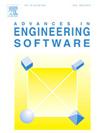A proposed innovative approach for predicting the torsional moment capacity of half-shaft based on static FEM
IF 4
2区 工程技术
Q2 COMPUTER SCIENCE, INTERDISCIPLINARY APPLICATIONS
引用次数: 0
Abstract
The torsional moment capacity of the automotive half-shaft is a crucial design parameter, and the utilization of induction hardening can enhance this capability. This paper presents the development of a comprehensive static finite element simulation model and a three-layer gradient distribution model of material property for the half-shaft based on its actual heat treatment state. A torque prediction model was developed for the torsional moment capacity of the half-shaft based on the torque-angle curve derived from the static finite element analysis. This model accurately and quickly predicts the torque value at which the half-shaft will break during the torsional test. In contrast with the current continuum damage mechanics method, this approach requires a reduced number of material factors and has a lower computing cost. Furthermore, the accuracy of the prediction results in three distinct groups of half-shafts reaches 94 %, 97 %, and 99.6 %. This approach can provide guidance for the design and enhancement of half-shafts, potentially replacing or minimizing the need for torsion testing of automotive half-shafts. It has the potential to minimize the duration of the product development cycle and lower the associated costs. It can also be applied to different drive shafts, demonstrating excellent adaptability and extensive applicability.
求助全文
约1分钟内获得全文
求助全文
来源期刊

Advances in Engineering Software
工程技术-计算机:跨学科应用
CiteScore
7.70
自引率
4.20%
发文量
169
审稿时长
37 days
期刊介绍:
The objective of this journal is to communicate recent and projected advances in computer-based engineering techniques. The fields covered include mechanical, aerospace, civil and environmental engineering, with an emphasis on research and development leading to practical problem-solving.
The scope of the journal includes:
• Innovative computational strategies and numerical algorithms for large-scale engineering problems
• Analysis and simulation techniques and systems
• Model and mesh generation
• Control of the accuracy, stability and efficiency of computational process
• Exploitation of new computing environments (eg distributed hetergeneous and collaborative computing)
• Advanced visualization techniques, virtual environments and prototyping
• Applications of AI, knowledge-based systems, computational intelligence, including fuzzy logic, neural networks and evolutionary computations
• Application of object-oriented technology to engineering problems
• Intelligent human computer interfaces
• Design automation, multidisciplinary design and optimization
• CAD, CAE and integrated process and product development systems
• Quality and reliability.
 求助内容:
求助内容: 应助结果提醒方式:
应助结果提醒方式:


